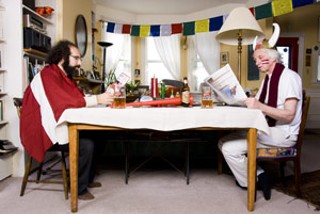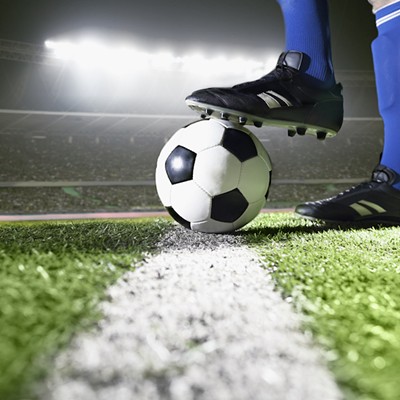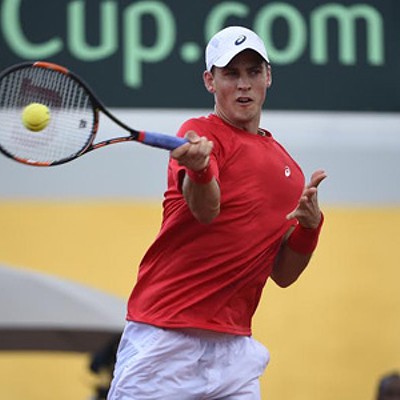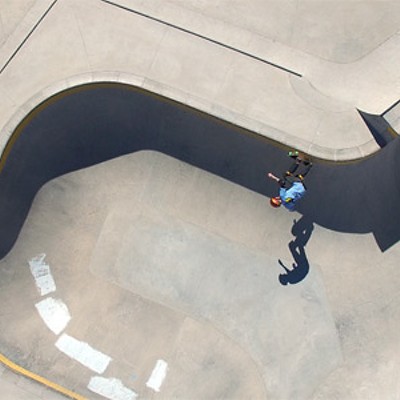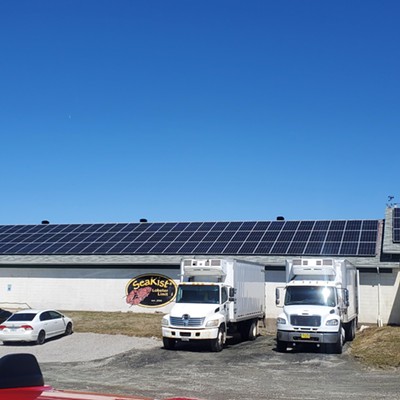Hanging on lampposts,the banners depict players in action, like oversized hockey cards. The standards for the 16 teams lead a rush along downtown streets tothe Halifax Metro Centre on Brunswick, where they swarm the building, crashing it like a net.
Look up, there's Cole Harbour's own Sidney Crosby, Sid the Kid, representing Team Canada in the International Ice Hockey Federation tournament, the early rounds of which are being held in Halifax this week. But he's not part of the Canadian contingent this year, at least as it stands now. Crosby's busy captaining his NHL team, the Pittsburgh Penguins, to an almost-certain berth in the Eastern Conference final (the Pens lead the Rangers 3-0 in their series at press time). His appearance up there above the street reveals some perhaps unintended irony, or wishful thinking among the organizers: "if only the Pens would start losing so Sidney could come play in Halifax and really generate excitement!"
The banner and the newly unveiled Sidney shrine at the Nova Scotia Sport Hall of Fame are a nice, homey touch, a show of pride from the host city for their hometown hero. But they also underscore the perennial problem for the World Championship, and arguably the international game itself: next to the simultaneous Stanley Cup contest, the international game will always come up short in terms of North American fan interest and support. The IIHF version of the sport belongs to someone else, others living elsewhere in the world.
Despite the mixed signals and the annual overlap with the NHL playoffs, tournament organizers in Halifax (surely the same goes for Quebec City, where the later rounds will be played) just want to be a good host city. But in a way, it's out of their hands: as with every year's IIHF go-round, the buzz is being brought in---imported---to the city by fans already sold on the international game and, in other cases, people interested in celebrating their culture.
There's Latvia, for example. "There will be 1,000 Latvian fans," coming over to support the team, says Robert Dambergs, a local Latvian community organizer, self-described entrepreneur and former architect. Since the Baltic state's return to independence---after five decades of Soviet occupation---in the early '90s, he's promoted economic, political and cultural ties between Latvia and Canada. For the tournament, he's organized fan nights, using the Economy Shoe Shop as fan base camp. With Latvian beer flowing from the taps, Latvian musicians Normunds Jakushonoks and Gunars Meiyers will play after each Team Latvia game---backed by local bands The Wandering Minds, Ron MacIntyre and the Geezers and others---downstairs at the Seahorse.
So, that's 1,000 Latvians exactly---no rounding up or down? "This is based on ticket sales. I'm not pulling a number out of a hat," says Dambergs. Then Halifax should ready itself for the nights of 1,000 Latvians. You may even get a chance to appear on Latvian TV, as a documentary crew is reportedly coming to capture the "fandemonium," as sports promoters and broadcasters would put it.
And that's not to discount the scores of Latvian-Canadians from elsewhere in the country set to visit and cheer on the boys from their ancestral homeland. In a way, these supporters are making the bigger, or more significant journey, by cheering on anothernation's team in hockey-mad Canada. They're straddling two distinct cultures by doing so.
All together now: 'Sarauj!'
Go find a Team Latvia banner---Latvija on the squad's burgundy and grey jerseys---and watch for folks tilting up to snap a photo of it, or bowing down beneath it. It could happen. Latvian hockey fans may be just that enthusiastic, devoted and unselfconscious. "I'm sure everyone in Halifax will notice them because they're loud and---I don't know if people would call them obnoxious---but they're fun-loving hockey fans," says Maris Blums. He's coming from Toronto with his brothers and buddies---five or six in all---to take seats in the Metro Centre. They're part of a larger group of 75 to 80 visiting Torontonians of Latvian descent
Latvia is one of three Baltic countries, a trio of small nations south of Finland on the shores of the Baltic Sea. Estonia is the northernmost, then Latvia and then Lithuania. They're all more or less nestled into---some might say smothered in---the western flank of Russia, which for 50 years harshly called the shots over the Baltic states along with the other former Soviet Socialist Republics. Latvia's population is almost 2.3 million. By comparison, Lithuania, the most populous, has almost four million and Estonia has the lowest population, with roughly 1.4 million people. By way of hockey metaphor, their size requires the Baltics, as they're collectively known, to play the global political and economic game in the manner of a quick, nimble and shifty---in the sport sense, mind---forward, as opposed to, say, the power-forward, who muscles defencemen off their game and scores from close range.
Given the chance, it may be proper, since officialdom often reminds Haligonians what good hosts they are---how welcoming and friendly---to share this bit of basic knowledge with a Latvian guest. Conversely, it would be discourteous, impolite to, for example, point to the Latvian banner and exclaim, 'Oh hey, it's...um... him!' when it's being paid due respect by visiting fans. Sure, the Latvians may not have a Sid the Kid on their banner, but they've nonetheless watched native sons go on to play in the NHL, having respectable careers. There was goalie Arturs Irbe, who got around in the league, and Sandis Ozolins was recently traded back to San Jose, a Cup contender from the Western Conference led by Canadian power-forward Joe Thornton and net-minded by Russian Evgeni Nabokov. But Ozolins is riding the bench, Blums points out.
Or, brush up on your Latvian hockey knowledge by reading Robert Dambergs' survey of the past 100 years of the game in Latvia, one of the few English items on the mostly Latvian-language blog hockeyhalifax.com. Dambergs goes from the first recorded game in 1909 through the country's 1931 entry into the IIHF through the siphoning of star players from Latvia and control from Moscow, to the immediate post-Soviet era. In 1992, Dambergs writes, the Latvian game was in a disheveled state, suffering from a lack of facilities and a scattering of players and teams. Still, they beat Estonia and Lithuania, the other two Baltics, to help them re-qualify for the IIHF under their own flag, out from under the Soviet yoke. Today in Latvia, Hockey Canada reports on its website, there are 16 rinks and 4,348 registered players.
Latvia made it to the IIHF's B pool in 1997 and went on to beat the Russian Federation's team twice, first in 2000 and then 2003.
If you meet someone like Paul Miklasevics, a 29-year-old equity trader and current president of the Latvian National Youth Association of Canada (he's coming from Toronto as part of the same group as Maris Blums), ask him about that first victory over Russia: "Here we are beating our former oppressor against insurmountable odds," he writes in an email, "and instead of rioting and generally going nuts, Latvian fans simply lay flowers at the gates of the Russian embassy. We're talking over 20,000 bouquets of flowers stacked 10 feet high, just to let them know, that, yes, we too feel their loss. Pure gold."
Of course if there are Russian team supporters in the area, try not to dwell on that point. That would be rude, as it would be to point and stare at Maris Blums and his brothers Vilnis and Karlis---triplets who just turned 29 a few weeks ago---when they're here wearing the Latvian colours, singing the anthem and yelling the chants. "Well, the standard chant for Latvians at hockey games is 'Sarauj!' which means, more or less, 'Get it together or let's get going,'" says Maris. That's appropriate for a team that tends to lose big to the bigger hockey forces in the tournament. Still, the plucky Latvians have transformed a classic gloating song of the imminent victor into their own call to action: "It's used in many different tunes...including the standard 'na-na-na-na-hey-hey-hey-goodbye' song. 'Sarauj Sarauj, Sarauj Sarauj, Hey, Hey, Hey, Latvia!'" Maris says. It wouldn't be out of line---here in Canada---to learn the call and back up your new Latvian friends when they take on the US on Friday, May 2.
Among the Brothers Blums, there's a clear hierarchy of fandom. "I'm the most , then Maris and then Karlis," Vilnis says. In fact, he and Maris have already committed to coming to Halifax, though Karlis isn't sure. "He keeps on changing his mind, but most likely he's coming."
Vilnis co-founded the Latvian Hockey Fan Club with another Latvian fan in Oakville, a suburban city west of Toronto, in 2006, spurred by the draft of several Latvian players into various junior league teams in Ontario. The fan club tracks and celebrates the moves and upstream progress of players on OHL rosters, including the Kingston Frontenacs, Peterborough Petes and St. Michael's Majors, not to mention those dressing in Syracuse Crunch (East Coast Hockey League) and Providence Bruins (American Hockey League) uniforms.
The fan club holds kids' days, when the kids come to meet the young players from the country where their grandparents or parents were born. The organizers regularly get between 150 and 200 Latvian-Canadian fans out to the St. Mike's games. "We have a booth out by the front gates and we hand out free Latvian food to people," Vilnis says. "We get into the stands, start cheering and just start to bring it up a beat because usuallythe fans around this area are pretty quiet.So it's much appreciated when we makesome noise."
The Blums brothers are chuffed about Team Latvia this year. Players, they say, are drawn from the best of European and North American clubs. And they're generally younger, such as Kaspars Daugavins, an OHL all-star left winger who played for the St. Mike's Majors and was recently drafted by the Ottawa Senators. As such, Daugavins now plays for the Sens' AHL farm team, the Binghamton Senators. "They didn't make the playoffs either," says Maris, with a laugh, of both versions of the Sens. Still, Daugavins soon turns 20, the youngest player ever on the Latvian team.
As per IIHF 2007 rankings, Latvia sits tenth of 16 spots, but they finished 13th in last year's World Championship tournament. They're in Group B this year, which means they face the US (Friday), Canada (Sunday, May 4) and Slovenia (Tuesday, May 6) in a round-robin preliminary round. The top three teams from each of the four groups then form two groups of six for a qualification round for another round-robin series. It's a safe bet that Latvia won't advance beyond the qualification round.
"I don't think Latvian fans ever have high expectations. As long as we stay in the top division and put a good performance in, no one will really care, they'll still cheer and chant," Maris says. But "there have been upsets." (Remember the Russians! There's a potential slogan.)
The Blums brothers were NHL fans first and then migrated to the international game. "I grew up as a Habs fan and then a Leafs fan in the '90s," Vilnis explains. "And then I started getting into the international game when Latvia made it to the elite division for the first time in '97. And they ended up finishing seventh or something like that." He doesn't pause when asked the difference in the style of play. "It's just a lot more wide-open, more skilled hockey instead of just dump-and-chase and grinding type of game. It can be more pleasant to watch."
And it's always nice to be noticed, for having shown up: With the World Championships, Vilnis sees the Latvian migration to Halifax as "an opportunity to show your colours, especially when you're from a small country like that, you don't get a chance often to display that. Most people don't even know where it is. It gives you a chance to show it out in the open."
Who are these guys, anyway?
Fandom---being a fan---often has little to do with playing a game. Vilnis Blums has never laced up the skates and hit the ice: "Not at all, other than street hockey. I didn't even skate until I was about 12 or something like that. I played ice hockey once or twice in my life."
And brother Maris? "We got to play street hockey but no ice hockey," he says. Before hockey, "The love of Latvian heritage always came first. Both of my parents were born in Latvia and came to Canada as DPs at a young age," Maris continues. Both he and Vilnis know their parents came through Halifax, Pier 21, as many Baltic peoples did during, and for several years after, the second World War. "They taught us Latvian before they taught us English. We always say we're hockey fans but we're not hockey players because we were always in Latvian school when everyone else was learning to skate and play hockey." Along with "heritage language classes," the brothers participated in Latvian Scouts and folk-dancing.
The support system, the community, always existed in Toronto. Roughly 14,000 Latvian-Canadians live in Greater Toronto, says Martin Sausins, president of the executive board of the Latvian National Federation in Canada. Some 80 percent of Latvians in Canada live in Ontario, with "a few hundred" that he knows of coming to the tournament. There are comparably smaller Latvian communities---a little over 400 in Montreal and around 100 in Vancouver and Calgary---dotting the map. Halifax doesn't even rank on a list of communities with fewer than 75 Latvian people (such as Winnipeg and Thunder Bay) mentioned by Sausins, who lives in the Ottawa area.
"A lot of people landed here and most people moved right through," says Lucas Dambergs, son of Robert, the events organizer. "But my grandfather got a job, I think it was with the Department of Fisheries and Oceans, as a lab scientist, and my grandmother opened a ballet school. She was a prima ballerina at the Latvian ballet in the '30s." As a boy, Dambergs visited his grandparents in their house on Jubilee Road, where he spoke the language, something he, unlike the Blums brothers, no longer can do. "I remember being able to speak a little bit of Latvian when I'd stay with my grandparents, before I started school and my parents were at work."
Over the years, Dambergs, now 30, has learned the family story. " parents left Latvia just before he was born. They had to flee because of the second World War," he says. " up in a Latvian household, very connected to the Latvian traditions. He was always very active in the Latvian community and got involved in the independence movement at the end of the Soviet Union and was active politically in Latvia, in terms of making a connection to Canada, and brought Latvian politicians to Canada."
There's a mix of familiarity with the story and pride in the old man evident in Lucas Dambergs' tone. "He has a lot of political, business and cultural connections in Latvia. He's really gone to great lengths to build those and maintain those." For Lucas' own first trip to Latvia in 2003, his father set him up with contacts and friends. He went back for a second trip in 2006, the same year Latvia hosted the IIHF World Championship. (Recalling his own trip to Latvia that year for the tournament, Maris Blums describes a scene akin to World Cup soccer: "You're walking down the streets and there's people in their home country's jerseys, and they're all just singing and having a good time, chanting. You go to the beer gardens and everyone's sitting together from the same country and there's friendly little rivalries...it's just hockey for the week or two of the championship.")
But Dambergs went to Latvia in '06 not for sport, but research related to his involvement with the Anchor Archive Zine Library and Ink Storm Printing Collective in Halifax. He was looking into models of other autonomous, artist-run centres around the world. His father, a craftsperson who makes jewellery, encouraged him to go.
"There was a real interesting situation in Latvia," Lucas Dambergs says. "At the end of Communism there was a resurgence of Latvian nationalism and non-profits were created to support this. So there was music and art and performance...all these small, artist-run-styled centres popped up."
He visited several of these small but sturdy organizations, which had survived the transition from Soviet control and centralization to autonomy and decentralization. One was a new media centre called Rixc (rixc.lv), which Dambergs describes as doing "world-class work. They created a field of new media art, locative media, which combines specific location with media. They created this, which is now happening all over the place. Now, at the Banff Centre there's a whole residency just around that.
"They coined the term and did the early research. They have almost no funding, no support from the government, but they're doing world-class work."
Also long involved in the Centre for Art Tapes, Dambergs focuses on experimental animation and interactive video projects these days. Though not a "rabid" hockey fan, he does keep an eye on NHL playoffs, the World Juniors and other international games. Like the Blums, he says, "I played road hockey, or ball hockey. I actually played ice hockey for the first time last year on a friend's pond near Antigonish."
Halifax, the alpha and the Zelta
"The tournament isn't just the tournament. It's also showing Latvia to Canada," Robert Dambergs says.
From the Halifax end, he's organized visits by Latvian representatives, including the country's ambassador to Canada, Margers Krams. For Dambergs, the economic link between Canada---more specifically Nova Scotia---and Latvia shows great potential. Asked for an example, he offers nano-technology. "Within the next few years Nova Scotia will be the springboard for trade and business links between our two countries," he says in an email after an initial phone conversation.
Sport is just the lens to view the country by, he says, including the way it kicks back and has fun. He encourages anyone to join the Latvians for beer, tunes and food, Latvian style---to see the "fun" side of Latvia.
This is a notable change in tone for a guy who once dogged prime minister Brian Mulroney and his external affairs (what is now foreign affairs) minister Joe Clark to recognize the Baltic states' independence from a crumbling Soviet Union in the early 1990s; this, Dambergs says, despite the pressure from president George Bush, Sr. and Secretary of State James Baker to hold off doing so, as it would trigger a "morass" among all the restless Soviet republics and surely bring down Gorbachev. Dambergs was part of a delegation of Canadian citizens, translators, officials and observers to travel to all three Baltic countries' capitals---Riga in Latvia, Vilnius in Lithuania and Tallinn in Estonia---to meet with independence leaders and politicians there. Iceland was first to recognize the states in 1991, then Denmark, followed by Canada. "And with Canada doing it," Dambergs says, "it was like an avalanche."
The previous year, he and an Estonian-Canadian named Jaan Soosar (then assignment editor at ATV News), had broken an international story about the training of Iraqi forces---this was after all the time of the Gulf War---in Riga's Bolder ja Harbour, Dambergs says, "to shoot and destroy American vessels." This, he points out, ran counter to the era's detente, the thaw of the Cold War, between the Americans and the Soviets. Dambergs and Soosaar arranged a live-to-air interview with then-foreign minister Janis Jurkans. "Jurkans confirmed that the Iraqi troops were being trained in Riga, which was then part of the Soviet Union under Gorbachev. Latvians would never have done that."
Going further back, to 1987, Dambergs protested the Soviet Union's hegemonic hold on Latvia and the other republics at a Canada Cup game between the USSR and Finland held in Halifax. But, he concludes, "We're past all that now."
Instead of rehashing those days, he'd rather pass you an icy cold Zelta (full name, Aldaris Zelta), and shoot the shit about the action on the ice, or life. Beer, of course, goes hand in glove, so to speak, with hockey. Vilnis Blums describes the Zelta as a "more flavourful Molson Canadian. It's a lager."
While Vilnis works for a shipping company (with his uncle) in Toronto that specializes in getting packages cheaply and efficiently to Europe---competing directly with UPS, FedEx and the like---his brother Maris works as brand manager for BGS Intertrade Ltd., a small company specializing in importing booze from around the world to be sold through the LCBO, Ontario's equivalent to the NSLC. Maris is supplying the Shoe Shop and Seahorse with the Zelta. On the BGS website, Aldaris Zelta is described "as a medium strong light malt beer brand, with characteristic clear malt and hop flavour. The enjoyable taste is created balancing sweetness of malt and medium sourness of hop. Colour---golden yellow."
They may not take gold on the ice, but Latvia wins just for showing up and playing the damn game against hockey powerhouses. "Hockey has been and is a very important part of Latvian life, especially today when a relatively small country is able to play the big-league countries," says Martin Sausins of the Latvian Federation of Canada.
Robert Dambergs echoes the sentiment, with a little more punch: "Now we're fighting on the ice. Let's see who the best man is."
Team Latvia plays Team USA, Friday, May 2, at 8:15pm, Team Canada, Sunday, May 4, 4:30pm and Team Slovenia, Tuesday, May 6, 8:15pm.Sean Flinn is a half-Estonian freelance writer in Halifax. He would like to announce the recent victory of the Estonian team over the Latvians in the Baltic Cup in Toronto (despite Vilnis Blums's claims that they had ringers).

